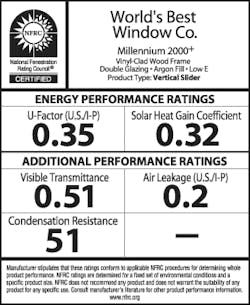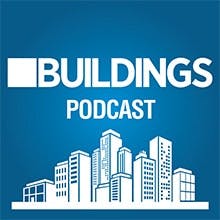Sustainable Solutions for Everyday Problems from Greenbuild
I wasn’t sure what to expect when I headed to my first Greenbuild International Conference & Expo. What I found was a buzzing expo floor full of invigorating ideas and innovative solutions for every building type and organizational mission.
Here are a few highlights from a busy two days.
Sustainable Solutions for Everyday Problems
National Fenestration Rating Council
Greenbuild is the place to be if you’re looking to specify healthier products, from windows to wood. Tom Herron of the National Fenestration Rating Council spoke with me about the organization’s energy performance label – literally a “nutrition label” of sorts for windows.
Watch this 360 video - you can use the arrow keys to get a full-circle view. Or read the transcription below.
Read the transcription...
Janelle: Hey, this is Janelle from Buildings magazine. I’m here with Tom Herron from the National Fenestration Rating Council. And we’re here to talk about energy performance ratings for windows. Tom, what can you tell us about what you’re speaking with people about at Greenbuild today?
Janelle: How have people responded to the NFRC Energy Performance Label so far?
Tom: Yeah. They really seem to like it because one of the things that helps them understand is how heat can escape from the window, or how heat can come in. And we give them the ability to make a comparison so they can get the products that are gonna suit their needs.
Janelle: Great. What are some of the things on the label?
A growing trend, these living walls have become an easy way for companies in a variety of sectors — healthcare, office, hospitality, etc. — to incorporate sustainable design into their building or facility while also promoting the health and well-being of employees.
Find out all of the benefits of living walls from Greenbuild 2018...
Tom: One of the things on the label is the U-factor. And this is the measure of heat loss. It tells you how much heat inside your house or building is escaping to the outside. And the other thing is the solar heat gain. And that’s the amount of heat from the sun that’s actually coming into your home.
Janelle: Great. Thanks, Tom. Any last advice for facilities managers that are interested in maybe using this label to shop for new windows?
Tom: Always look for the NFRC label.
Janelle: Great. Thank you so much.
Pioneer Millworks
I also spotted this beautiful display by Pioneer Millworks, where sustainably harvested offerings come from sources as varied as old fences and industrial buildings in the U.S. to teak homes in Indonesia.
Much of the wood is certified with the Forest Stewardship Council and is used to create paneling, flooring, custom woodworking fixtures and more.
Watch this 360 video - you can use the arrow keys to get a full-circle view. Or read the transcription below.
Read the transcription...
Janelle: This is Janelle Penny from Buildings magazine and I’m here in the Pioneer Millerworks’ booth with Jonathan Orpin. Jonathan, what am I looking at?
Jonathan: Well, our booth is sort of different than you often see. It’s really just a mosaic of all of our colors, our textures, our species that we get from all over the place. And what we do is we reclaim wood and we reclaim it from old fences, big industrial buildings, bridges, old houses in Indonesia for all that matters. And it comes to our reclaim team. So, all over the place, packing materials and then we turn it into fun things like flooring and paneling and cabinets and timbers, a lot of timbers.
Janelle: Have you noticed any trends in what people are asking for commercially?
Jonathan: Commercially?
Janelle: Yeah.
Jonathan: We’re starting to see - our rugged look has been really well-received for many years and still is. We are starting to see some push now towards a cleaner, more modern look. And we can do that as well. It really is just how much patina do you want left on the outside.
So, we are seeing some of that as well. We also see an importance towards the ability to have a fire rating, which is critically important. And we apply a Class B and Class A fire rating on the surface when needed and that helps out as well in the commercial zone.
Janelle: Great. I noticed that in your booth, you have a sign about asking for FSC-certified products. Are they all FSC-certified? What can you tell me about that?
Jonathan: Almost all. Yeah. We’re really a big believer in the FSC process, Forest Stewardship Certification. And we’ve been chain-of-custody-certified for, I don’t know, maybe 10 years. And for me, FSC is really the only real third-party, independent, international organization that is first and foremost about sustainability and not just about the industry it represents. So, I like that. Almost everything we do is FSC.
There are some things that aren’t, either because I don’t care. For instance, if it’s a timber that has fallen down in an urban setting, well, I guarantee I can’t get an FSC rating on that. But it works great. All of our reclaimed is FSC-certified because that’s what we are. And our fresh-sawn is about 50% FSC-certified. And very excitedly, our Indonesian partner, where we get our reclaimed teak from, just finished their FSC certification. And I’m really excited about that.
Architectural Salvage: Benefits of Reusing Old Buildings
What happens to the buildings that aren’t in good enough shape to upgrade?
Empty, decaying buildings are an eyesore – but demolishing them means valuable, reusable materials take up space in a local landfill.
Find out what Architectural Salvage Warehouse of Detroit is doing instead.
[podcast]
Read the article or listen to the podcast. (Or do both...)
Janelle: Great. Can you show me some of the examples of some of the more popular woods that people have been asking for?
Jonathan: Well, I sure can.
Janelle: I see you’ve got a lot of different colors.
Jonathan: For instance, here’s a big favorite. It’s our black and tan 50/50 series. It’s oak that came from horse fencing in Kentucky and the Kentucky Bluegrass region. So that fencing comes down every 20 years. It’s black painted. We either leave all of the paint on like this piece. Or we plain some of it off. We call it our 50/50 series. Or we’ll plain it all off and this piece around here called our black and tan-tan. And so, that’s been a big seller for us. It’s a pretty affordable, it’s a hard wood, you know. Oak’s great. And it gives us a lot of opportunity to vary the look.
Janelle: Sure. Do you find that people have misconceptions about how sustainable wood really is?
Jonathan: Gosh, I don’t know. What do you mean? I don’t understand the question.
Janelle: Sure. Well, you know, when you think of wood, at least when I think of wood, sometimes I might think of cutting down a tree to make lumber for example. But do you find that people are generally pretty aware that so much reclaimed stuff is available?
Jonathan: Well, I don’t think reclaimed is new news. And particularly in this crowd. You know, reclaim is normal. I will say that even wood that comes from a cut-down tree is more sustainable as a building material and almost anything else. Because trees regrow. Concrete doesn’t. Steel doesn’t. So I think wood in general is pretty renewable. And sure, the FSC certification process that you asked about before helps with that because those are certified (unintelligible) sustainable forest. But wood’s a pretty good product.
Certification Strategies
The new version of the RELi resilient design certification and a net zero energy program, LEED Zero, both made their formal debut at the event. The emergence of programs like these are a credit to designers and building owners and managers who continually push the envelope when it comes to creating and operating better buildings.
“All of those things that we’re now starting to see come in are essentially driven by what the people working in these buildings are asking,” says Alisdair McGregor, fellow and global mechanical engineering leader for Arup. “Companies who are buying and leasing the buildings want to find the buildings that meet these needs.”
Material Health and Transparency: Easier Than Ever
Materials Pavilion
Greenbuild dedicated an entire pavilion on the expo floor to mindful materials – products that clearly label every ingredient. In many cases, those labels weren’t something attendees had to ask manufacturers for – they were front and center.
One vendor, ASSA ABLOY, showcased a row of Declare product labels at the very front of its booth so that they were the first thing visitors saw.
The materials pavilion was a favorite of material health expert Frances Yang of Arup, who noted that clients are increasingly savvy about material contents and other aspects of projects that weren’t part of the conversation even a few years ago.
“There’s more recognition of value. People are starting to bring in things like triple bottom line analysis,” she explains. “In addition to lifecycle costs, there are also benefits that bring value where you can proximally monetize some of these things. It’s easier to talk about value when you put it all in the same units.”
Watch this 360 video - you can use the arrow keys to get a full-circle view. Or read the transcription below.
Read the transcription...
This is Janelle Penny, senior editor at BUILDINGS, and I’m wrapping up my day at Greenbuild in the Materials Pavilion where I’m seeing a lot of concentration and a lot of attention paid to product transparency.
I’m just here at the Assa Abloy booth where I can see several Declare labels. If you’re not familiar, Declare is a product transparency label that lays out the major ingredients of product. Here we can see one for a lead cover. It’s got a nice listing of what’s in it and also whether or not it complies with the Living Building Challenge Red List, which can be difficult.
Really, I’ve been impressed with the amount of attention paid to product transparency. It’s not always easy to find that information. But some of the manufacturers here have done a really impressive job.
Greenbuild is truly more than a trade show - it’s an experience.
Walking the expo floor and checking out educational sessions reveal a thriving community of green building professionals determined to make a positive impact on the industry. Take a closer look at some of the sophisticated technologies I spotted on the floor, including tunable white lighting, stunning green walls and easily recycled steel.
About the Author
Janelle Penny
Editor-in-Chief at BUILDINGS
Janelle Penny has been with BUILDINGS since 2010. She is a two-time FOLIO: Eddie award winner who aims to deliver practical, actionable content for building owners and facilities professionals.


